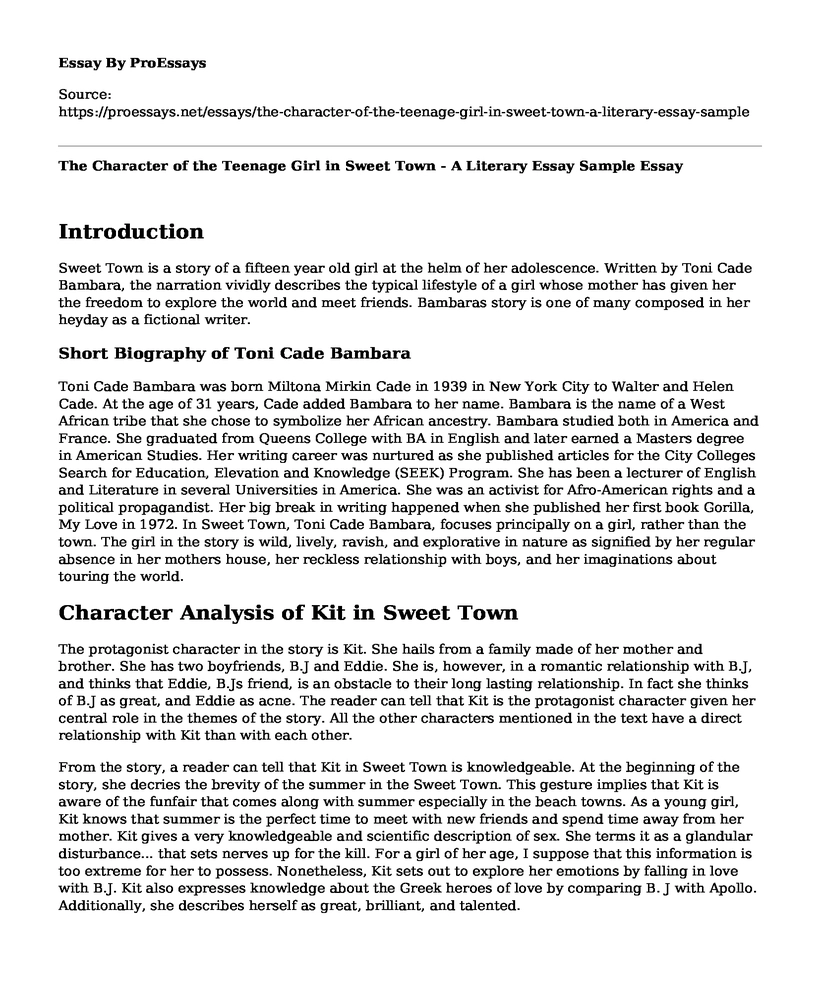Introduction
Sweet Town is a story of a fifteen year old girl at the helm of her adolescence. Written by Toni Cade Bambara, the narration vividly describes the typical lifestyle of a girl whose mother has given her the freedom to explore the world and meet friends. Bambaras story is one of many composed in her heyday as a fictional writer.
Short Biography of Toni Cade Bambara
Toni Cade Bambara was born Miltona Mirkin Cade in 1939 in New York City to Walter and Helen Cade. At the age of 31 years, Cade added Bambara to her name. Bambara is the name of a West African tribe that she chose to symbolize her African ancestry. Bambara studied both in America and France. She graduated from Queens College with BA in English and later earned a Masters degree in American Studies. Her writing career was nurtured as she published articles for the City Colleges Search for Education, Elevation and Knowledge (SEEK) Program. She has been a lecturer of English and Literature in several Universities in America. She was an activist for Afro-American rights and a political propagandist. Her big break in writing happened when she published her first book Gorilla, My Love in 1972. In Sweet Town, Toni Cade Bambara, focuses principally on a girl, rather than the town. The girl in the story is wild, lively, ravish, and explorative in nature as signified by her regular absence in her mothers house, her reckless relationship with boys, and her imaginations about touring the world.
Character Analysis of Kit in Sweet Town
The protagonist character in the story is Kit. She hails from a family made of her mother and brother. She has two boyfriends, B.J and Eddie. She is, however, in a romantic relationship with B.J, and thinks that Eddie, B.Js friend, is an obstacle to their long lasting relationship. In fact she thinks of B.J as great, and Eddie as acne. The reader can tell that Kit is the protagonist character given her central role in the themes of the story. All the other characters mentioned in the text have a direct relationship with Kit than with each other.
From the story, a reader can tell that Kit in Sweet Town is knowledgeable. At the beginning of the story, she decries the brevity of the summer in the Sweet Town. This gesture implies that Kit is aware of the funfair that comes along with summer especially in the beach towns. As a young girl, Kit knows that summer is the perfect time to meet with new friends and spend time away from her mother. Kit gives a very knowledgeable and scientific description of sex. She terms it as a glandular disturbance... that sets nerves up for the kill. For a girl of her age, I suppose that this information is too extreme for her to possess. Nonetheless, Kit sets out to explore her emotions by falling in love with B.J. Kit also expresses knowledge about the Greek heroes of love by comparing B. J with Apollo. Additionally, she describes herself as great, brilliant, and talented.
Conclusion
Kits overrated knowledge about philosophy and science is her weakness as well as her strength. She understands that by appealing to the emotions of her mother by expressing contact will make the latter grant her absolute freedom. On the other hand, this knowledge exposes her to immoral behavior.
Cite this page
The Character of the Teenage Girl in Sweet Town - A Literary Essay Sample. (2021, Apr 08). Retrieved from https://proessays.net/essays/the-character-of-the-teenage-girl-in-sweet-town-a-literary-essay-sample
If you are the original author of this essay and no longer wish to have it published on the ProEssays website, please click below to request its removal:
- Paper Example on Racism in William Shakespeare's Othello
- The Freudian Unconscious Essay
- The Surge of Nationalism: Race, Nationalism, and War Essay Example
- Essay Sample on African American Slave History
- Essay Sample on Mental Disorders: Exploring Other Approaches for Improving Thinking
- Everyday Use: Preserving African-American Heritage - Essay Sample
- Free Research Paper Example on Myths and Mythology







